 Int. J. Communications, Network and System Sciences, 2011, 4, 549-561 doi:10.4236/ijcns.2011.49066 Published Online September 2011 (http://www.SciRP.org/journal/ijcns) Copyright © 2011 SciRes. IJCNS Parallel Minimax Searching Algorithm for Extremum of Unimodal Unbounded Function Boris S. Verkhovsky Department of C om put er Science, New Jersey Institute of Technology, Newark, USA E-mail: verb73@gmail.com Received June 27, 20 1 1; revised August 1, 2011; accepted Augu st 25, 2011 Abstract In this paper we consider a parallel algorithm th at detects the maximizer of unimo dal function () x comput- able at every point on unbounded interval (0, ) . The algorithm consists of two modes: scanning and detecting. Search diagrams are introduced as a way to describe parallel searching algorithms on unbounded intervals. Dynamic programming equations, combined with a series of liner programming problems, describe relations between results for every pair of successive evaluations of function f in parallel. Properties of optimal search strategies are derived from these equations. The worst-case complexity analysis shows that, if the maximizer is located on a priori unknown interval (n 1, ] n , then it can be detected after parallel evaluations of /2 1( p ()2log1) 1 p cn n ( ) x, where p is the number of processors. Keywords: Adversarial Minimax Analysis, Design Parameters, Dynamic Programming, Function Evaluation, Optimal Algorithm, Parallel Algorithm, System Design, Statistical Experiments, Time Complexity, Unbounded Search, Unimodal Function 1. Introduction and Problem Statement Design of modern systems like planes, submarines, cars, aircraft carriers, drugs, space crafts, communication net- works etc. is an expensive and time consuming process. In many cases the designers must run and repeat expen- sive experiments, while each run is a lasting process. The goals of these experiments can be either to maximize performance parameters (speed, carried load, degree of survivability, healing effect, reliability etc.) or to mini- mize fuel consumption, undesirable side effects in drugs, system’s cost etc. Performance parameters that are to be maximized (or minimized) are functions of other design parameters (wing span in aircrafts, aerodynamic characteristics of cars, planes, helicopters, raising cars, antennas or hy- drodynamic profiles of submarines, ships etc.). At the best, these functions are computable if CAD is applicable. Otherwise, multitude of wind tunnel experiments is re- quired for aero- or hydrodynamic evaluations. Analo- gously, numerous statistical experiments on animals and later on different groups of people are necessary if a new drug is a subject of design. Such experiments may last months or even years. For instance, in the USA devel- opment of a new drug takes in average ten-twelve years. In view of all factors listed above, it is natural to mini- mize the number of experiments in attempts to design a system with the best parameters. In most of the cases, we can estimate an upper bound on the design parameter under consideration ; yet this is not always the case espe- cially if the cost of experiments is increasing or even can be fatal in design of new drugs. The unbounded search problem, as d escribed in [1], is a search for a key in a sorted unbounded sequence. The goal of the optimal unbounded search is to find this key for a minimal number of comparisons in the worst case. The authors describe an infinite series of sequential algo- rithms (i.e., using a single processor), where each algo- rithm is more a ccurate, than the p revious algorith m. In [2] the unbounded search problem is interpreted as the fol- lowing two-player game. Player chooses an ar b itrar y positive integer . Player may ask whether the in- teger nB is less than . The “cost” of the searching algorithm is the number of guesses that must use in order to determine . The goal of the player is to use a minimal number of these guesses in the worst case. nB nB 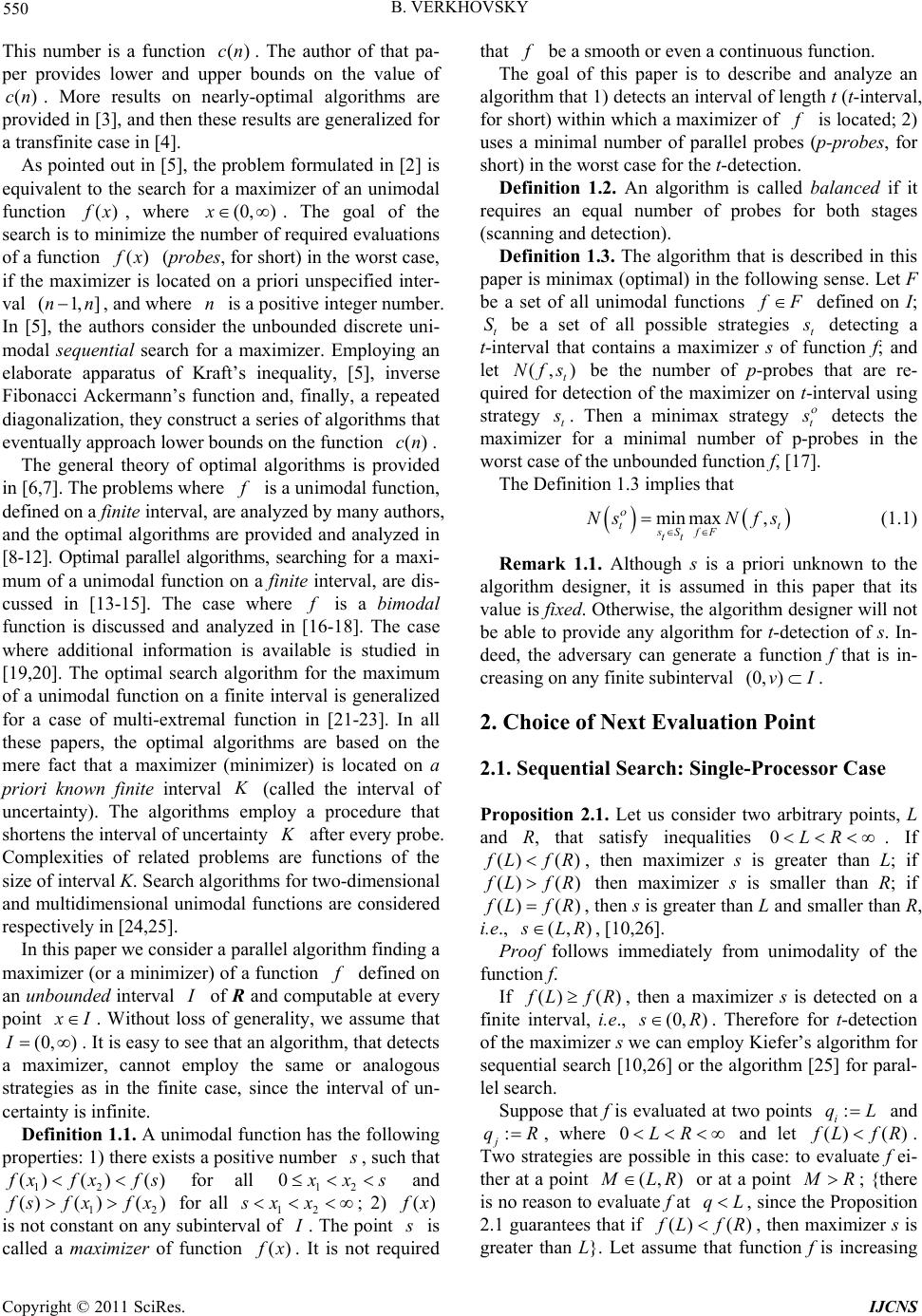 B. VERKHOVSKY 550 ue o n [4]. This number is a function . The author of that pa- per provides lower and upper bounds on the valf ()cn . More results on nearly-optimal algorithms are provided in [3 ], and then these resu lts are generalized for a transfinite case i ()cn As pointed out in [5], the problem formulated in [2] is equivalent to the search for a maximizer of an unimodal function () x, where . The goal of the search is to minimize the number of required evaluations of a function (0,x) () x (probes, for short) in the worst case, if the maximizer is located on a priori unspecified inter- val , and where is a positive integer number. In [5], the authors consider the unbounded discrete uni- modal sequential search for a maximizer. Employing an elaborate apparatus of Kraft’s inequality, [5], inverse Fibonacci Ackermann’s function and, finally, a repeated diagonalization, they construct a series of algorithms that eventually approach lower bounds on the function . (1n,]nn ()cn The general theory of optimal algorithms is provided in [6,7]. The problems where is a unimodal function, defined on a finite interval, are analyzed by many authors, and the optimal algorithms are provided and analyzed in [8-12]. Optimal parallel algorithms, searching for a maxi- mum of a unimodal function on a finite interval, are dis- cussed in [13-15]. The case where is a bimodal function is discussed and analyzed in [16-18]. The case where additional information is available is studied in [19,20]. The optimal search algorithm for the maximum of a unimodal function on a finite interval is generalized for a case of multi-extremal function in [21-23]. In all these papers, the optimal algorithms are based on the mere fact that a maximizer (minimizer) is located on a priori known finite interval (called the interval of uncertainty). The algorithms employ a procedure that shortens the interval of uncertainty after every prob e. Complexities of related problems are functions of the size of interval K. Search algorithms for two-dimensional and multidimensional unimodal functions are considered respectively in [24,25]. K K In this paper we consider a parallel algor ithm find ing a maximizer (or a minimizer) of a function defined on an unbounded interval of R and computable at every point I , ). Without loss of generality, we assume that . It is easy to see that an algorithm, that detects a maximizer, cannot employ the same or analogous strategies as in the finite case, since the interval of un- certainty is infinite. (0I Definition 1.1. A unimodal function has th e following properties: 1) there exists a positive number , such that 12 ()()() xfxfs for all 12 0 xs and 12 () () () sfx fx for all 12 ; 2) sx x () x is not constant on any subinterval of . The point is called a maximizer of function () x. It is not required that be a smooth or even a continuous function. The goal of this paper is to describe and analyze an algorithm that 1) detects an interv al of length t (t-interval, for short) within which a maximizer of is located; 2) uses a minimal number of parallel probes (p-probes, for short) in the worst case for the t-detection. Definition 1.2. An algorithm is called balanced if it requires an equal number of probes for both stages (scanning and detection). Definition 1.3. The algorithm that is described in this paper is minimax (optimal) in the following sense. Let F be a set of all unimodal functions F defined on I; t be a set of all possible strategies t S detecting a t-interval that contains a maximizer s of function f; and let be the number of p-probes that are re- quired for detection of the maximizer on t-interval using strategy t (,) t sNf . Then a minimax strategy t detects the maximizer for a minimal number of p-probes in the worst case of the unbound ed function f, [17]. The Definition 1.3 implies that min max, tt sS fF tt NsN fs (1.1) Remark 1.1. Although s is a priori unknown to the algorithm designer, it is assumed in this paper that its value is fixed. Otherwise, the algorithm designer will not be able to provide any algorithm for t-detection of s. In- deed, the adversary can generate a function f that is in- creasing on any finite subinterval . (0,)vI 2. Choice of Next Evaluation Point 2.1. Sequential Search: Single-Processor Case Proposition 2.1. Let us consider two arbitrary points, L and R, that satisfy inequalities 0. If LR () ()fL fR , then maximizer s is greater than L; if then maximizer s is smaller than R; if () () ()fLfR ()fLfR , then s is greater than L and smaller than R, i.e., (,) LR , [10,26]. Proof follows immediately from unimodality of the function f. If , then a maximizer s is detected on a finite interval, i.e., () ()fL fR(0, ) R . Therefore for t-detection of the maximizer s we can employ Kiefer’s algorithm for sequential search [10,26] or the algo rithm [25] for paral- lel search. Suppose that f is evaluated at two points : i qL and : j qR , where 0LR and let () () LfR . Two strategies are possible in this case: to evaluate f ei- ther at a point (, ) LR or at a point R; {there is no reason to evaluate f at , since the Proposition 2.1 guarantees that if q () L () LfR, then maximizer s is greater than L}. Let assume that function f is increasing Copyright © 2011 SciRes. IJCNS  B. VERKHOVSKY 551 on interval (, )LR . Therefore, s is either on finite interval (,RR) or on infinite interval . Keeping in mind that we consider the worst case complexity, it is reasonable to evaluate f at a point Rs R that is on the infinite inter- val . ,R 2.2. Multiprocessor Case Let us consider the same function () x as in the single processor case. Let us simultaneously evaluate it at points 1,, M, where p is the number of available processors. Consider four scenarios: A: All or a part of the points 1,, M are inside interval ; (, )LR 1 B: All points ,, M ,, 1 are outside interval , i.e., every point (, )LR M [,] is larger than R; C: RR [,] ; D: RR . 2.3. Possible Outputs in the Worst Case For both AC and AD scenarios () x and can be selected in such a way that for all , for which i 1ip (, ) LM, the inequality i () () MfR holds. Hence, taking into account that we are dealing with the worst case, all evaluations must be done outside interval if (, )LR ()() Lf qq R. 3. Optimal Unbounded Search Algorithm as a Two-Player Game with Referee 3.1. Sequential Search: (p = 1) Let us consider two players A and B and a referee. Their game consists of two stages. At the beginning, player A selects a value 0s and informs the referee about it. Player B selects a value t > 0 and informs player A and the referee about his choice. At the first stage, B sequentially selects positive and distinct points 12 ,,, i q. The referee terminates the first stage if there are points q and k q such that q and k q. The second stage begins from state 11 1 (,, )uvw where : 11 uq; : 1 vq; : 11 wq. At the second stage, B selects points and A selects in- tervals. Let the game be in state (,,) jj uvw of the sec- ond stage. This stage terminates if jj wu t. Other- wise B selects a point j v, such that jj uxw . Then A eliminates the leftmost or the rightmost subin- terval, [16]. The goal of player B is to minimize the number of points required to terminate the game. The goal of player A is to maximize the number of these points. The adversarial approach for interpretation of the optimal search algorithms is also considered in [2,27]. Remark 3.1. It is easy to see that B is an algorithm designer and A is a user that selects function f and re- quired accuracy t. 3.2. Multiple-Processor Search: (p ≥ 2) An optimal parallel search algorithm with p processors has an analogous interpretation. In this case, at the first phase of the game, player B on his move selects p dis- tinct positive points. The referee terminates the first phase if there are at least two points to the right from s. At the beginning of the second phase, the player A se- lects any two adjacent subintervals and eliminates all other subintervals. In general, at the second phase, B selects points and A selects intervals. More specifically, player B on his move selects p distinct points on the in- terval and player A on her move selects any two adjacent subintervals and eliminates all other subintervals. The goal of the game is the same as in the single-processor case. It is obvious that on the first stage of the game player B must select all points in an increasing order from one p-probe to another. Remark 3.2. At first, we will describe the optimal unbounded searching algorithm with one processing element, (PE, for short). Subsequently, we will describe and discuss the parallel minimax unbounded search with p PEs. As it will be demonstrated, the case where p is an even integer is simpler than the case where p is odd. 4. Structure of Unbounded Sequential Search Consider a finite interval K, i.e., its length K . In the case, if it is known a priori that K, then we can t-detect maximizer s for at most log 1 toKt probes, where 152 , [16,17]. (4.1) However, the situation is more complicated if f is de- fined on unbounded interval In this case we divide entire interval I into an infinite set of finite subin- tervals of uncertainty11 (0, ).I 0, ]:( q ; 212 :(, ] qq; ; 1 :(,] kkk qq ; where 1k k I . (4.2) In this paper it is demonstrated that a minimax search algorithm consists of two major modes: a scanning (ex- panding) mode and a detecting (contracting) mode. Let us assume for simplicity of notations that for all integer k Copyright © 2011 SciRes. IJCNS  552 ) B. VERKHOVSKY :( k ffqkk Definition 4.1. A search algorithm is in the scanning mode while for all function f satisfies inequalities . , i.e., is a result of the k-th probe. f 12 k qq q f 12 k In the scanning mode we probe intervals until this mode terminates. ff 12 ,,,, k II I Definition 4.2. We say that a search algorithm is in l-th state 1 of the scanning mode if l-th in- terval of uncertainty 1] lll {,} lll prr (, qq is to be eliminated and is the next evaluation point. Here 1l q 11 : ll rq l qI l ; 11ll l rq q ffl Remark 4.1. If 1ll, then the search switches into the detecting mode with initial state 1, [16]. However, if 1ll , then the search moves to the next 1l state of the scanning mode. As a result, the interval of uncertainty 1l I . {,} ll rr ff p is eliminated (since1l I ) and the inter2l val is the next to be examined. Since at any state the search can switch into the detecting mode, the dilemma is whether to select interv2l al as small as possible (in preparation for this switch) or, if the search continues to stay in the scanning mode, to select 2l as large as possible. The dilemma indicates that there must be an optimalic choe of 2l . In the detecting mode, we can use an optimal strategy, [10,16,26], which locates s on t-interval. To design a minimax search algorithm, we must select all 12 1k in such a way, that the total number of required probes on bo th modes is minimal in the worst case. qqq Definition 4.3. We say that a set of points is a detecting triplet if ( ,,) ijk qqq ij fff kk , where . (4.3) ij qqq If is a detecting triplet and f is a unimodal function, then maximizer s satisf ies inequality k (, , ) ijk qqq i qsq , [17]. Definition 4.4. In the following consideration, means the minimal total number of required probes for both modes in order to detect maximizer s in the worst case if (,)Ubc (, ] bc. In the following discussion, we assume that t = 1, unless it is specified otherwise. Proposition 4.1. If f is an unimodal function and , but this is a priori unknown, then for all s is detectable after probes in the worst case, i.e., 1 (1, mm sF F 3m1] 2( 2)m 11,1 22 mm UF Fm (4.4) where probes are used in the scanning mode and probes in the detecting mode. Here 1m 3mm is m-th Fibonacci number: ; 12 1FF 21mm m F F for m > 2. Proof {by induction}: We will demonstrate that in the scanning mode the optimal evaluation points 12 1 ,,, , oooo k qqq q k must satisfy these properties: 1:1, o q 1: oo kk k qq F , for all , i.e., 2k k 2 1 : o ki k i qFF 2 . (4.5) Remark 4.3. First, we demonstrate how to find an ap- proximation a of s that satisfies inequality at , i.e., ats at . Then we will show how to adjust the algorithm, if (1,] nn (2, F . 1). Let 34 2](0,1sF ]. Consider 1 1q 22q . Then 12 . Hence, Proposition 4.1 implies that ff 2 , )(0 q . Thus, 22aq implies that (0,1]a ; therefore 1 at ). It is easy to verify that, if (0,1s and 0 , then, in the worst case, two probes are not sufficient for detection of s on t-interval. Indeed, the adversary can select such s and f that satisfy the following inequalities: 12 1 and 12 qsq ff . Hence, in that case, s is not t-detectable on inter- val after two probes. (0,1] 2) Let now 1 (2,2 mm sF F ) and . Then s can be t-detected for mk 1 s(2, 2)2 mm FF m 1 probes. If , then k probes were used in the scanning mode and mk3k probes in the detecting mode. 3) Let 12 (1, kk sF F 1] 1, 2,,ik , but it is a priori un- known. Let for all 1, 2k :1 ii qF the probes are taken in the points 2 . In this case the following inequalities hold 12 1kk k2 ffff . Since 12kk k ff , then 12 is a de- tecting triplet, and, as a result, the search is in the detect- ing state 12 {, . Then from [8,10,26], using the optimal search algorithm, we can detect s with accuracy t = 1 for additional k evaluations of f. Hence the minima l total number of required probes for both modes is equal (, ,) kk k qqq } kk FF 12 (2, 2) k F 2 tk UF k1 . Q.E.T. 5. Optimal Balanced Sequential Search 5.1. The Algorithm Assign a required accuracy t; {the scanning mode of the algorithm begins}; :Lt ; ; :2Rt while () () LfR do begin :temp L ; :LR ; ; (5.1) :RRtempt {(5.1) generates a sequen ce of probing states , 12 {, },FF 1 {, kk } F }; end; {the maximizer s is detected: (,) temp R; the algo- rithm is in the detecting state {Ltemp ,RL }; Copyright © 2011 SciRes. IJCNS 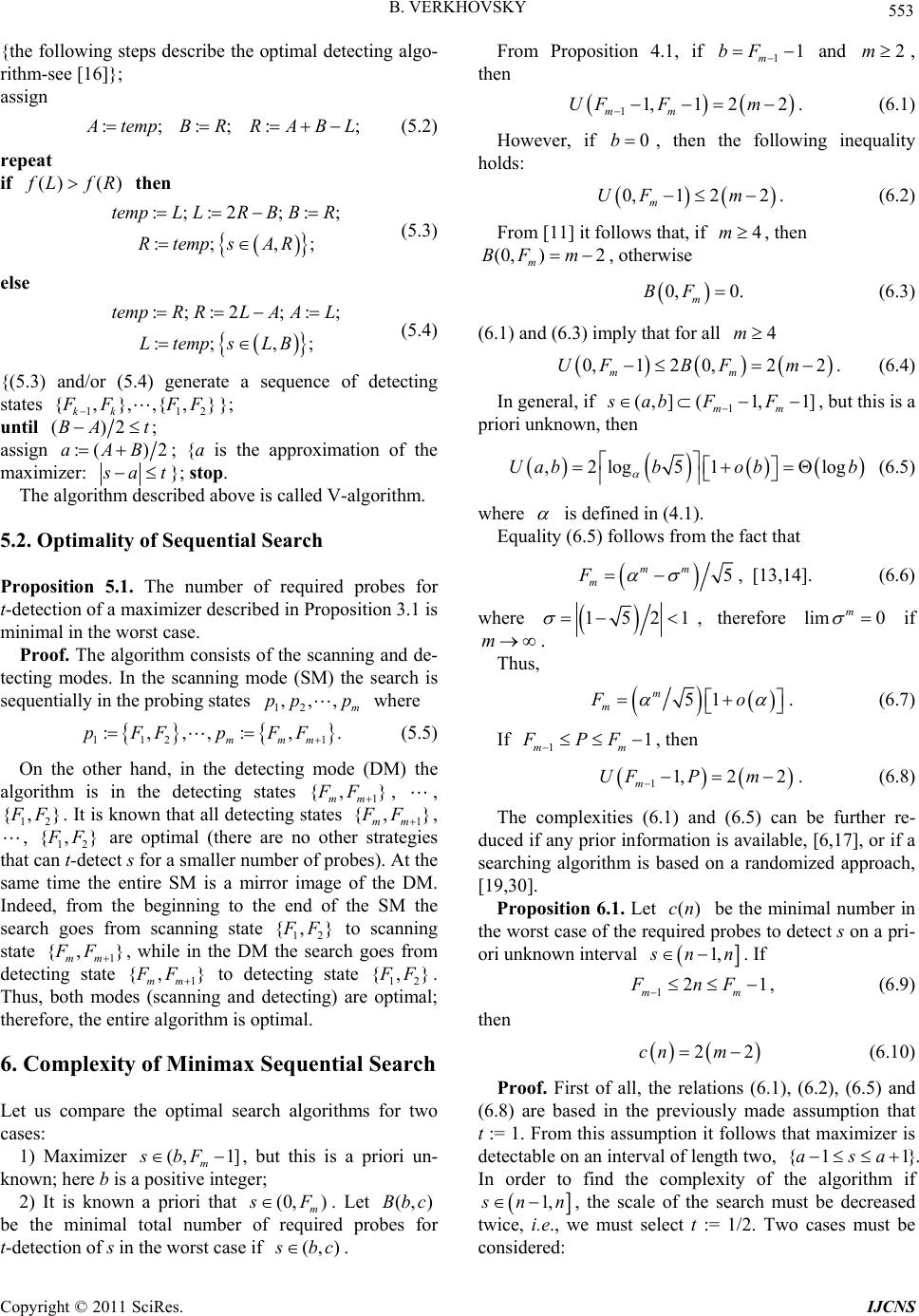 B. VERKHOVSKY 553 {the following steps describe the optimal detecting algo- rithm-see [16]}; assign :; temp (5.2) :;BR:RABL; repeat if () () LfR then :;:2 ;: :; ,; tempL LRB BR RtempsAR ; ; 2 } (5.3) else :;:2;: :; ,; tempR RLA AL LtempsLB (5.4) {(5.3) and/or (5.4) generate a sequence of detecting states 11 {,},,{, kk FFF }; until ()2;BA t assign :( )2aAB ; {a is the approximation of the maximi zer: at}; stop. The algorithm described above is called V-algorithm. 5.2. Optimality of Sequential Search Proposition 5.1. The number of required probes for t-detection of a maximizer described in Proposition 3.1 is minimal in the worst case. Proof. The algorithm consists of the scanning and de- tecting modes. In the scanning mode (SM) the search is sequentially in the probing states where 12 ,,, m pp p 112 1 :,,,: , mmm pFFp FF . (5.5) On the other hand, in the detecting mode (DM) the algorithm is in the detecting states , , 1 1 {,} mm FF 2 {, } F {, . It is known that all detecting states 1, , 12 {,FF} mm } F are optimal (there are no other strategies that can t-detect s for a smaller number of probes). At the same time the entire SM is a mirror image of the DM. Indeed, from the beginning to the end of the SM the search goes from scanning state 12 {, } F to scanning state 1, while in the DM the search goes from detecting state 1 {, to detecting state 12 {, {, mm FF}} mm FF } F. Thus, both modes (scanning and detecting) are optimal; therefore, the entire algorithm is optimal. 6. Complexity of Minimax Sequential Search Let us compare the optimal search algorithms for two cases: 1) Maximizer , but this is a priori un- known; here b is a positive integer; (, 1] m sbF 2) It is known a priori that (0,) m F (, . Let be the minimal total number of required probes for t-detection of s in the worst case if (,)Bbc ) bc. From Proposition 4.1, if and , then 11 m bF 2m 11,1 22 mm UF Fm . (6.1) However, if 0b , then the following inequality holds: 0,1 22 m UF m . (6.2) From [11] it follows that, if , then 4m (0,)2 m BFm , otherwise 0, 0. m BF (6.3) (6.1) and (6.3) imply that for all 4m 0,12 0,22 mm UFBF m . (6.4) In general, if 1 (,] (1,1] mm sab FF , b ut this is a priori unknown, then ,2log 51logUabb obb (6.5) where is defined in (4.1). Equality (6.5) follo ws from the fact that 5 mm m F , [13,14]. (6.6) where 152 1 m , therefore lim 0 if . m Thus, 51 m m Fo . (6.7) If 11 mm FPF , then 11,22 m UFP m . (6.8) The complexities (6.1) and (6.5) can be further re- duced if any prior information is available, [6,17], or if a searching algorithm is based on a randomized approach, [19,30]. Proposition 6.1. Let be the minimal number in the worst case of the required probes to detect s on a pri- ori unknown interval ()cn 1, nn. If 12 m FnF 1 m , (6.9) then 22cn m (6.10) Proof. First of all, the relations (6.1), (6.2), (6.5) and (6.8) are based in the previously made assumption that t := 1. From this assumption it follows that maximizer is detectable on an interval of length two, . In order to find the complexity of the algorithm if {1 1asa } 1, nn , the scale of the search must be decreased twice, i.e., we must select t := 1/2. Two cases must be considered: Copyright © 2011 SciRes. IJCNS  554 B. VERKHOVSKY Case 1: If 111 m tn and ; (6.11) 1 m nF t then (6.10) is implied by (6.5) if t :=1/2. Case 2: If 11 mm tn Ft and (6.12) 11 m Ftn 1, i.e., the case where 11 m t is in the middle of the interval 1,nnm. It occurs if In this case the left half of the interval mod3 0. 1,nn is out of interval 11, m t 1 m t , i.e., 1 ,1 mm tF t 1 2F 1,1/nn and, as a result, fewer probes are required for t-detection of s. However, in the worst case, the maximizer may be on the right half of interval 1,nn, hen ce for both cases. For illustration see Ta- ble 6.1 below. () 2(cn m2) Thus, (6.8) implies that 2log2514.cnn on (6.13) 7. Estimated Interval of Uncertainty In many applications, an upper bound value Q on maxi- mizer s can be estimated from a feasibility study. Let 5TQ d .Q Here 451.082.d Proposition 7.1. If T , then V-algorithm re- quires fewer probes than Kiefer’s algorithm, [14]; if TsT , then Kiefer’s algorithm and V-algorithm require the same number of probes; if , then Kiefer’s algorithm requires fewer probes than V-algo- rithm. TsQ Proof. Let and . Then in the worst case : m TF1 m 22 :m QF 11 22 0,11, 1 0,2 2 mm m UFUF F BF m . (7.1) It is easy to check that the proof follows from (6.7) and from the fact that 2 22 51 mm Fo m . (7.2) Preliminary results on analysis of the optimal algo- rithm searching for the maximum of a multimodal func- tion on the infinite interval are provided in [28]. Table 6.1. Total number of probes as function of n. 46n 494798n 60,697 98,208n 10cn 30cn 50cn 8. Parallel Search: Basic Properties If several processors are available, then, as it is indicated in [29], the algorithm can be executed in a parallel mode. [13,15] are the earliest papers on a parallel search for a maximum of a unimodal function of one variable on a finite interval, that are known to the author of this paper. Although the optimal search strategies in both papers are in essence identical, the formulation of the problem is different. The proof of optimality of the search is more detailed in [15]. [2] provides an idea of a parallel algo- rithm searching for a maximum of a unimodal function on a unbounded interval. This idea is based on an appli- cation of the Kraft’s inequality formalism, is provided in [2]. The authors indicate that the approach they used to construct an infinite series of near-optimal algorithms for the unbounded search with a single processor can be ex- panded for a multiprocessor case. However, no details are provi d ed. The search algorithm described in this paper is based on the following properties. Proposition 8.1: Let us consider p arbitrary points 1,, qq that satisfy inequalities 1 0p qq . (8.1) If 12 1 p ff f , (8.2) then maximizer s is greater than if 1; p q 12 1 p ff f , (8.3) then s is smaller than if 2;q 11 1 , jj p fff f (8.4) then s is greater than 1 q and does not exceed 1 q , i.e., 11 , jj sqq . (8.5) Proof follows immediately from unimodality of func- tion f. 9. Search on Finite Interval: Principle of Optimality Definition 9.1. (,) p m uv {,}.uv is a minimal in the worst case interval of uncertainty containing maximizer s that can be detected after m p-probes if the search starts from the detecting state 9.1. Properties of , p m Iuv 1) p l , p m, uv l; ) (Effectiveness of p-probes); I uv if (9.1m Copyright © 2011 SciRes. IJCNS  B. VERKHOVSKY Copyright © 2011 SciRes. IJCNS 555 2) 1122 , p ml , p5) , pp mm uv (Monot I uv if 12 uu; 12 vv , cu cvcIuv for every ; (9.5) 0c; (9.2) 3) onicity of uncertainty); (Homogeneity). p mm ,, p uvI vu; (Symmetricity); (9.3) 9.2. Properties of (,) p m uv if p = 2 4 ) , , pq mm uv I Efficiency of paral uv if pq; (9.4) (leliza tion);Proposition 9.1: Let . Then uv (9.6) (9.6) is a functional equation of dynamic programming; it implies the following property. Proofs of this and the follow- 13 12 22 11 131313 , 2 22 1211 211 22 min max,max,,,max,; ,min min max,max,,,max,. mm yuyv m mm yyu IuyyyIy uyvy IuvIy yuyyIuyy yv ing Propositions 9.2-9.5 are provided in the Appendix. Proposition 9.2: Let uv; then 21 2 21 , if ; 2 , ,; 0 if . m m m uv Iv uv Iuv uzzzu uv (9.7) .3. Odd Number of Processors roposition 9.3: If ; and then 9 P21pruv, 21 1 r1 21 21 1 ,, 1; ,,1 , 1; m r mr m rk vk uku rkvkkrkvukrk Iu vIrkvkukurkvrk krkvuk (9.8) here for ) 2 w1/kr er branch of 2 (1) (rkvkuku rkv (9.8) and for 0/kr in the upp wer branch of () (1)()rkvkuku rkv in the lo (9.8). 9.4. Even Number of Processors roposition 9.4: If P2pr and then for all uv, 12kr the fg dynamprogramming : ollowinic equation holds 21 2 21 1,11, 11 (,) 1,, 1, 01. r m r mr m ; rkvkukurkvrkrkvukrk Iuv Iuvrzzkurkvzuvk (9.9) .5. Defining Rules of Optimal Detecting States efinition 9.2. If there exists a pair of positive numbers and 9 2121 1 ,, rr mmmm mmm IcdIdcrd , (9.11) whic h means that D c and d such that c>d and for all non-negative numbers u and v uv 1:; mm cd 1: mm m dcrd ; p is even, then (9.12) Proposition 9.6. if cd (,)(, ), pp mm uvI cd (9.10) then is an opimal detecting st two propositions can be proved by in- du 22 1 ,1,,d rr mm IcdIcd rd {, }cd finitio timal detecting state. Den 9.3. Let {, } kk cd be the opt ate starting from whin be located after k addi- tional p-probes. The following ch s ca ction: Proposition 9.5. if p is odd, then mm mmmm which means that 11 :; :1 mm m mmm ddzc cdrd 1 . (9.13) Remark 9.1. t m dcons in (9.13). 1) and 2) im (9.12) and (9 op states ; ply defining rules.13) for timal detecting,} k d; here 01 { k cz 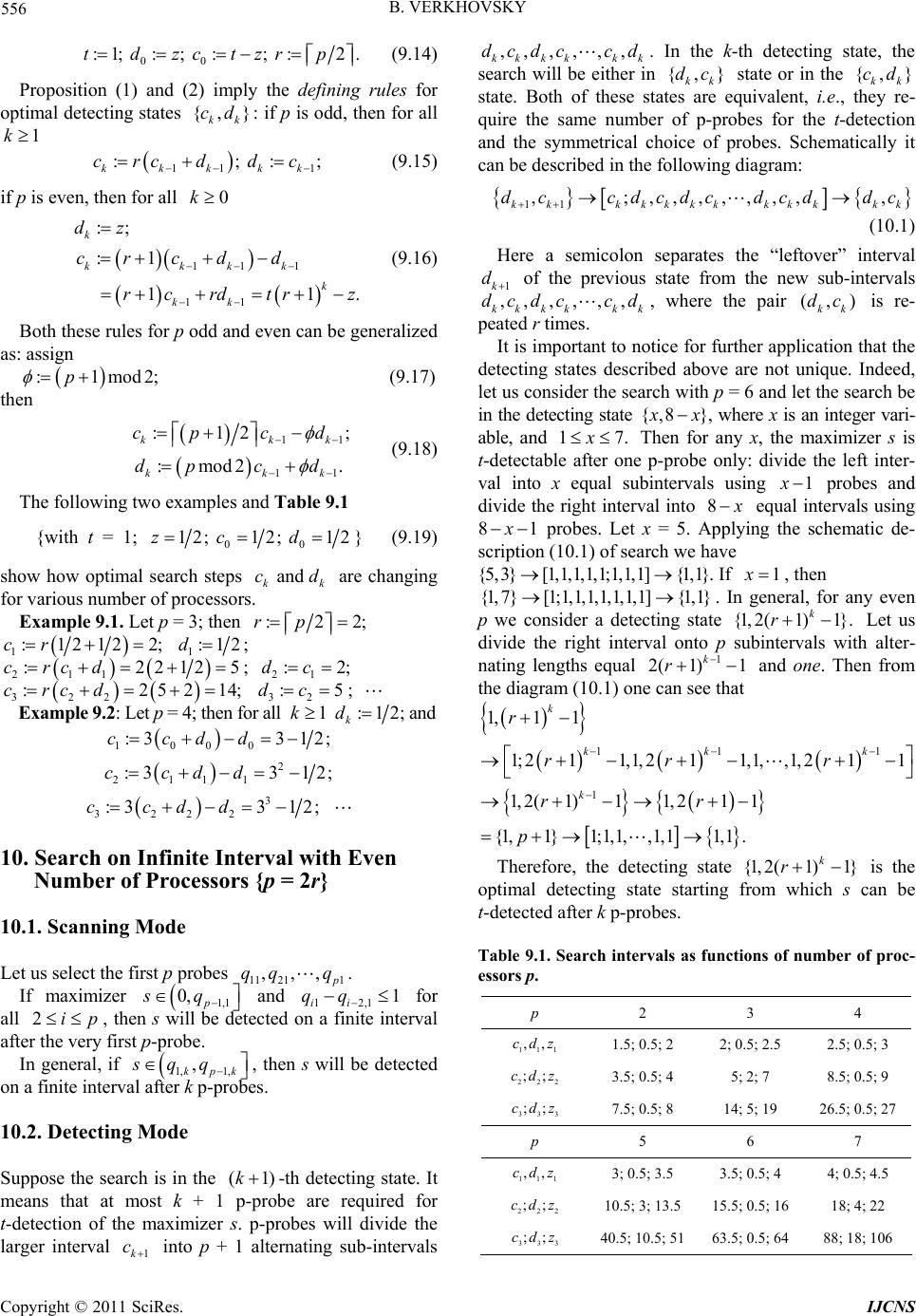 556 B. VERKHOVSKY 00 :1; :; :; :2.tdzctzrp (9.14) Proposition (1) and (2) imdefining rulesply the optimal detecting states : if p is odd, t if p is even, then for all . (9.16) Both these rules for p odd and even can be generalized as: assign for hen for all {,} kk cd 1 111 :;:; kk kk crc c (9.15) k k d d 0k :1crc 111 11 :; 11: k kkkk k kk dz d d rc rdtrz :1mod2;p (9.17) then 11 12; kk p cd 11 : :mod2. k kkk c dpcd (9.18) The following two examples and Table 9.1 {with t = 1; 00 12; 12; 12zc d} (9.19) show how steps k ar for vf processors optimal search e changing arious number o and k cd . Example 9.1. Let p = 3; the n :22; rp 1:12122;cr 1:12d; 11 :22125rcd; 2 322 :252crcd Example 9.2: Let p = 4; then for c21 :2dc 14;:5c; ; 32 d all 1k :12 k d ; and 1000 :3 312;ccdd 2 21 :33 ;ccdd 1112 3 3222 :33 12;ccdd 10. Search on Infinite Interval wi Even Number of Processors {p = 2r} bes th 10.1. Scanning Mode Let us select the first p pro11 211 ,,, qq q. and qq If maximizer 1,1 0, p sq t12,1 1 ii on a fite inte for ected rval -probe. general he )th detecting state. It e are required for alternating all 2ip , then s will be deni after the very first p In, if 1, 1, , kpk sqq , then s will be detected on a finite interval after k p-p r o bes. 10.2. Detecting Mode Suppose the search is in t eans that at most k (1k- + 1 p-prob s. p-pr m t-detection of the maximizer obes will divide the larger interval into p + 1 sub-intervals ,,,,,, kk kkk k dcdc cd. In the k-th detecting state, the search will be either in {,} kk dc state or in the {, } kk cd state. Both of these states are equivalent, i.e., they re- er of p-probes for the t-detection and the symmetrical chprobes. Schematical can be described in the following diagram: 1k c quire the same numboice of ly it 11 ,;,,,,,,, , k kkkkkkkkkkk d ccdcdcdcddc (10.1) Here a semico 1k dlon separates the “leftover” interval of the prev ,,,,,, kk kkk k dcdc cd peIt detecting states descri in ious state from , where t p = the new sub-i he pair nique. 6 and let the search ntervals ) Ibe (,dc kk ated r times. is important to notice for further application that the bed above are not undeed, let us consider the search with is re- the detecting state {,8 } x , where x is an integer vari- able, and 17.x Then for any x, the maximizer s is t-detectable after one p-probe only: divide the left inter- val into x equal subs using 1 interval probes and divide the rval into 8 right inte equal intervals using 81 probes. Let x = 5. Applying the schematic de- scription (10.1) of search we h av e {5, 3}[1,1,1,1,1;1,1,1]{1,1}1x, then [1;1,1,1,1,1,1,1] {1,1}. In general, for any even p we consider a detecting state {1, k . If onto 1)k r {1,7} divide the right interval nating lengths equal 2( 1) 1}r ubintervals with alter- . Let us p s 112( and one. Then from the diagram (10.1) one can see tha t 11 1 1,1 1 1;21 1,1,21 1,1, k kk k r rr 1 1r 1 1, 2( 1)1 {1,1}1;1,1, , k p 1, 21 ,1 1,1 rr ,1, 2 1 1 . } is the can be Therefore, the optimal detecting state starting f t-detected after k p-pr detecting state s. k {1, 2(1)1r rom which s obe Table 9.1. Search intervals as functions of number of proc- essors p. p 2 3 4 111 ,,cdz 1.5; 0.5; 2 2; 0.5; 2.5 2.5; 0.5; 3 222 ;;cdz 3.5; 0.5; 4 5; 2; 7 8.5; 0.5; 9 26.5; 0.5; 27 p 333 ;;cdz 7.5; 0.5; 8 14; 5; 19 5 6 7 111 ,,cdz 3; 0.5; 3.5 3.5; 0.5; 4 4; 0.5; 4.5 222 ;;cdz 10.5; 3; 13.5;18; 4; 22 4 5 15. 6 0.5; 16 333 ;;cdz 0.5; 10.5; 513 .5; 0.5; 6488; 18; 106 Copyright © 2011 SciRes. IJCNS 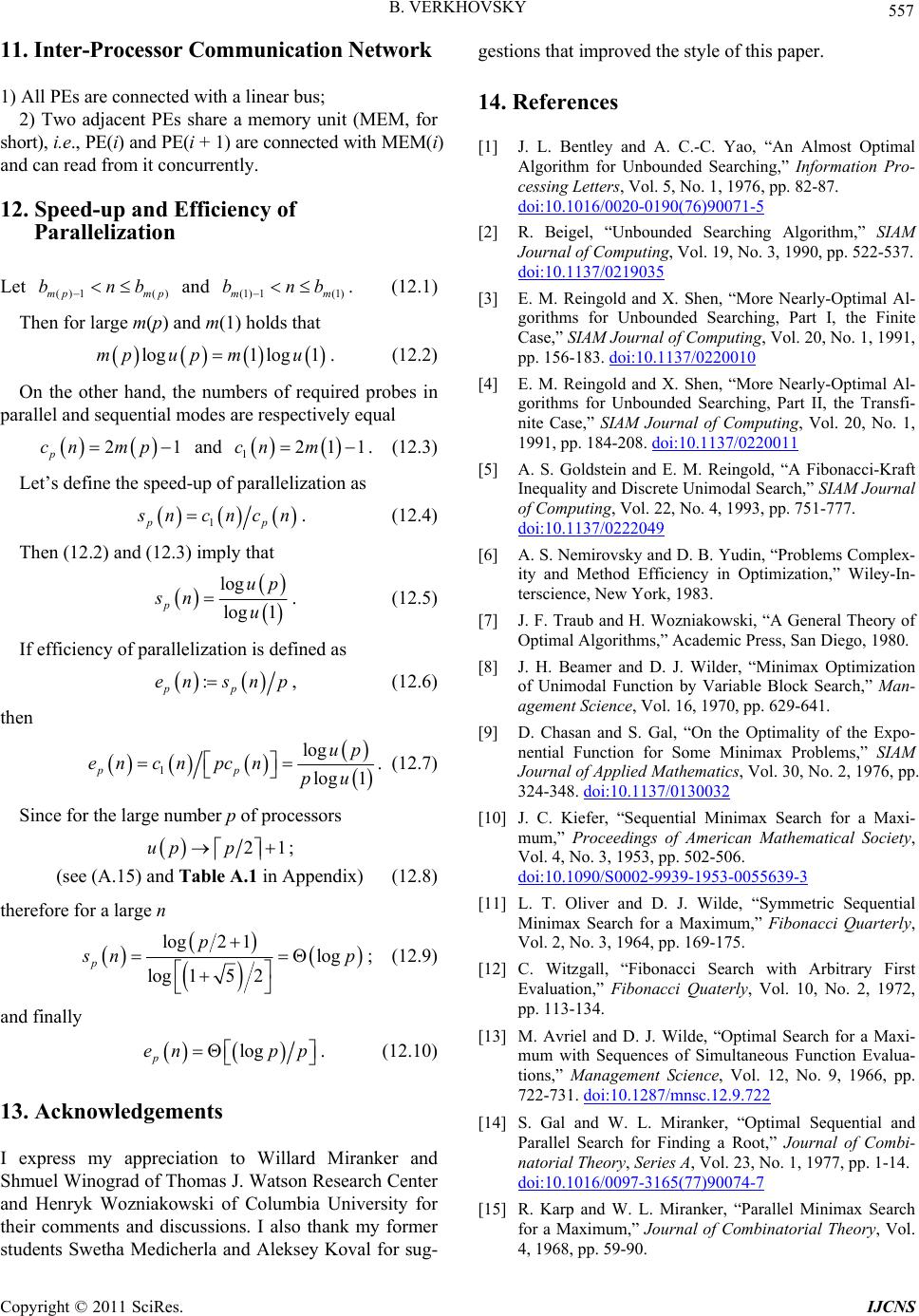 B. VERKHOVSKY 557 11. Interomon k ort), i.e., PE(i) and PE(i + 1) are connected with MEM( i) . (1 Then for large m(p) and m(1) holds that ed probes in parallel and sequential modes are respectiv -Prcessor ComunicatiNetwor 1) All PEs are connected with 2) Two adjacent PEs share a memory unit (MEM, for a linear bus; sh and can read from it concurrently. 12. Speed-up and Efficiency of Parallelization Let ()1 ()mp mp bnb and (1) 1 bnb (1)mm 2.1) log1 log1mpumu . p (12.2) On the other hand, the numbers of requir ely equal 21 p cn mp and 1211cn m. (12.3) Let’s define the speed-up of parallelization as 1pp nc cn. n (12.4) Then (12.2) and (12.3) imply that log log 1 pu up sn. If efficiency of parallelization is define (12.5) d as : pp en snp, ( th 12.6) en 1log 1 pp en cn pcnpu Since for the large number p of processors logup. (12.7) 21up p ; therefore for a large n (see (A.15) and Table A.1 in Appendix) (12.8) log2 1log p log p15 2 np ; (12.9) and finally log p en pp . (12.10) 13. Acknowledgements Willard Miranker and J. Watson Research Ce nd Henryk Wozniakowski of Columbia University for ] J. L. Bentley and A. C.-C. Yao, “An Almost Optimal Information Pro- Vol. 5, No. 1, 1976, pp. 82-87. I express my appreciation to Shmuel Winograd of Thomas nter a their comments and discussions. I also thank my former students Swetha Medicherla and Aleksey Koval for sug- gestions that improved the style of this paper. 14. References [1 Algorithm for Unbounded Searching,” cessing Letters, doi:10.1016/0020-0190(76)90071-5 [2] R. Beigel, “Unbounded Searching Algorithm,” SIAM Journal of Computing, Vol. 19, No. 3, 1990, pp. 522-537. doi:10.1137/0219035 [3] E. M. Reingold and X. Shen, “More Nearly-Optimal Al- gorithms for Unbounded Searching, Part I, the Finite Case,” SIAM Journal of Computing, Vol. 20, No. 1, 1991, pp. 156-183. doi:10.1137/0220010 [4] E. M. Reingold and X. Shen, “More Nearly-Optimal Al- gorithms for Unbounded Searching, Part II, the Transfi- nite Case,” SIAM Journal of Computing, Vol. 20, No. 1, 1991, pp. 184-208. doi:10.1137/0220011 [5] A. S. Goldstein and E. M. Reingold, “A Fibonacci-Kraft Inequality and Discrete Unimodal Search,” SIAM Journal of Computing, Vol. 22, No. 4, 1993, pp. 751-777. doi:10.1137/0222049 [6] A. S. Nemirovsky and D. B. Yudin, “Problems Complex- ity and Method Efficiency in Optimization,” W terscience, New York, iley-In- 1983. er, “Minimax Optimization , 1976, pp. [7] J. F. Traub and H. Wozniakowski, “A General Theory of Optimal Algorithms,” Academic Press, San Diego, 1980. [8] J. H. Beamer and D. J. Wild of Unimodal Function by Variable Block Search,” Man- agement Science, Vol. 16, 1970, pp. 629-641. [9] D. Chasan and S. Gal, “On the Optimality of the Expo- nential Function for Some Minimax Problems,” SIAM Journal of Applied Mathematics, Vol. 30, No. 2 324-348. doi:10.1137/0130032 [10] J. C. Kiefer, “Sequential Minimax Search for a Maxi- mum,” Proceedings of American Mathematical Society, Vol. 4, No. 3, 1953, pp. 502-506. doi:10.1090/S0002-9939-1953-0055639-3 [11] L. T. Oliver and D. J. Wilde, “Symmetric Sequential Minimax Search for a Maximum, Vol. 2, No. 3, 1964, pp. 169-175. ” Fibonacci Quarterly, ement Science, Vol. 12, No. 9, 1966, pp. [12] C. Witzgall, “Fibonacci Search with Arbitrary First Evaluation,” Fibonacci Quaterly, Vol. 10, No. 2, 1972, pp. 113-134. [13] M. Avriel and D. J. Wilde, “Optimal Search for a Maxi- mum with Sequences of Simultaneous Function Evalua- tions,” Manag 722-731. doi:10.1287/mnsc.12.9.722 [14] S. Gal and W. L. Miranker, “Optimal Sequential and Parallel Search for Finding a Root,” Journal of Combi- natorial Theory, Series A, Vol. 23, No. 1, 1977, pp. 1-14. doi:10.1016/0097-3165(77)90074-7 [15] R. Karp and W. L. Miranker, “Parallel Minimax Search for a Maximum,” Journal of Combinatorial Theory, Vol. 4, 1968, pp. 59-90. Copyright © 2011 SciRes. IJCNS 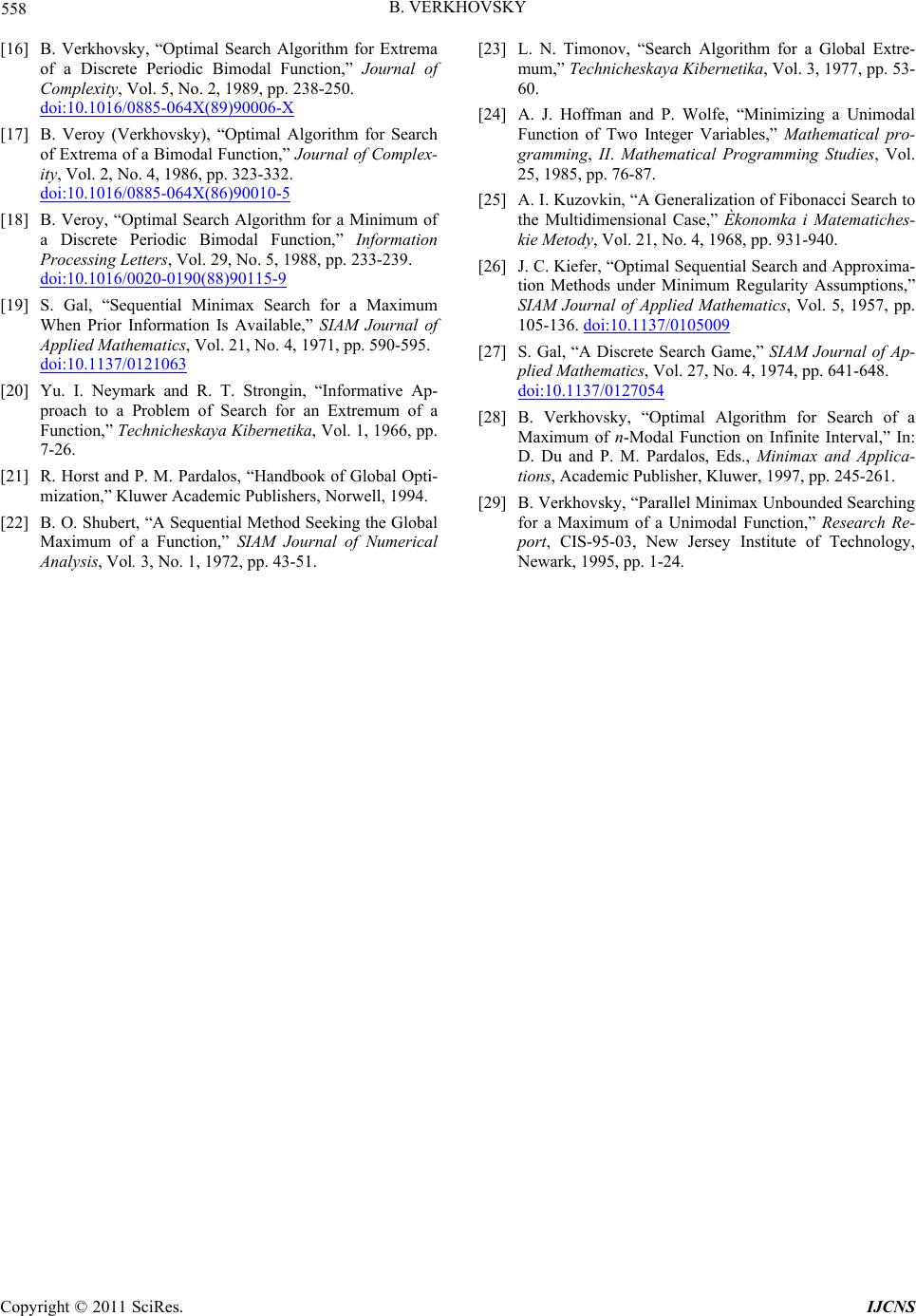 B. VERKHOVSKY Copyright © 2011 SciRes. IJCNS 558 No. 2, 1989, pp. 238-250. [16] B. Verkhovsky, “Optimal Search Algorithm for Extrema of a Discrete Periodic Bimodal Function,” Journal of Complexity, Vol. 5, doi:10.1016/0885-064X(89)90006-X [17] B. Veroy (Verkhovsky), “Optimal Algorithm for Search of Extrema of a Bimodal Function,” Journal o ity, Vol. 2, No. 4, 1986, pp. 323-332. f Complex- doi:10.1016/0885-064X(86)90010-5 [18] B. Veroy, “Optimal Search Algorithm for a Minimum of a Discrete Periodic Bimodal Func Processing Letters, Vol. 29, No. 5, 19tion,” Information 88, pp. 233-239. doi:10.1016/0020-0190(88)90115-9 [19] S. Gal, “Sequential Minimax Search for a Maximum When Prior Information Is Available,” SIAM Journal Applied Mathematics, Vol. 21, No. 4,of 1971, pp. 590-595. doi:10.1137/0121063 [20] Yu. I. Neymark and R. T. Strongin, “Informative Ap- proach to a Problem of Search for an Extremum of a Function,” Technicheska ya Kibernetika, Vol. 1, 1966, pp ubert, “A Sequential Method Seeking the Glob a Global Extre- . Hoffman and P. Wolfe, “Minimizing a Unimodal eneralization of Fibonacci Search to proxima- . 7-26. [21] R. Horst and P. M. Pardalos, “Handbook of Global Opti- mization,” Kluwer Academic Publishers, Norwell, 1994. [22] B. O. Shal Maximum of a Function,” SIAM Journal of Numerical Analysis, Vol. 3, No. 1, 1972, pp. 43-51. [23] L. N. Timonov, “Search Algorithm for mum,” Technicheskaya Kibernetika, Vol. 3, 1977, pp. 53- 60. [24] A. J Function of Two Integer Variables,” Mathematical pro- gramming, II. Mathematical Programming Studies, Vol. 25, 1985, pp. 76-87. [25] A. I. Kuzovkin, “A G the Multidimensional Case,” Èkonomka i Matematiches- kie Metody, Vol. 21, No. 4, 1968, pp. 931-940. [26] J. C. Kiefer, “Optimal Sequential Search and Ap tion Methods under Minimum Regularity Assumptions,” SIAM Journal of Applied Mathematics, Vol. 5, 1957, pp. 105-136. doi:10.1137/0105009 [27] S. Gal, “A Discrete Search Game,” SIAM Journal of Ap- plied Mathematics, Vol. 27, No. 4, 1974, pp. 641-648. doi:10.1137/0127054 [28] B. Verkhovsky, “Optimal Algorithm for Search of a g Maximum of n-Modal Function on Infinite Interval,” In: D. Du and P. M. Pardalos, Eds., Minimax and Applica- tions, Academic Publisher, Kluwer, 1997, pp. 245-261. [29] B. Verkhovsky, “Parallel Minimax Unbounded Searchin for a Maximum of a Unimodal Function,” Research Re- port, CIS-95-03, New Jersey Institute of Technology, Newark, 1995, pp. 1-24. 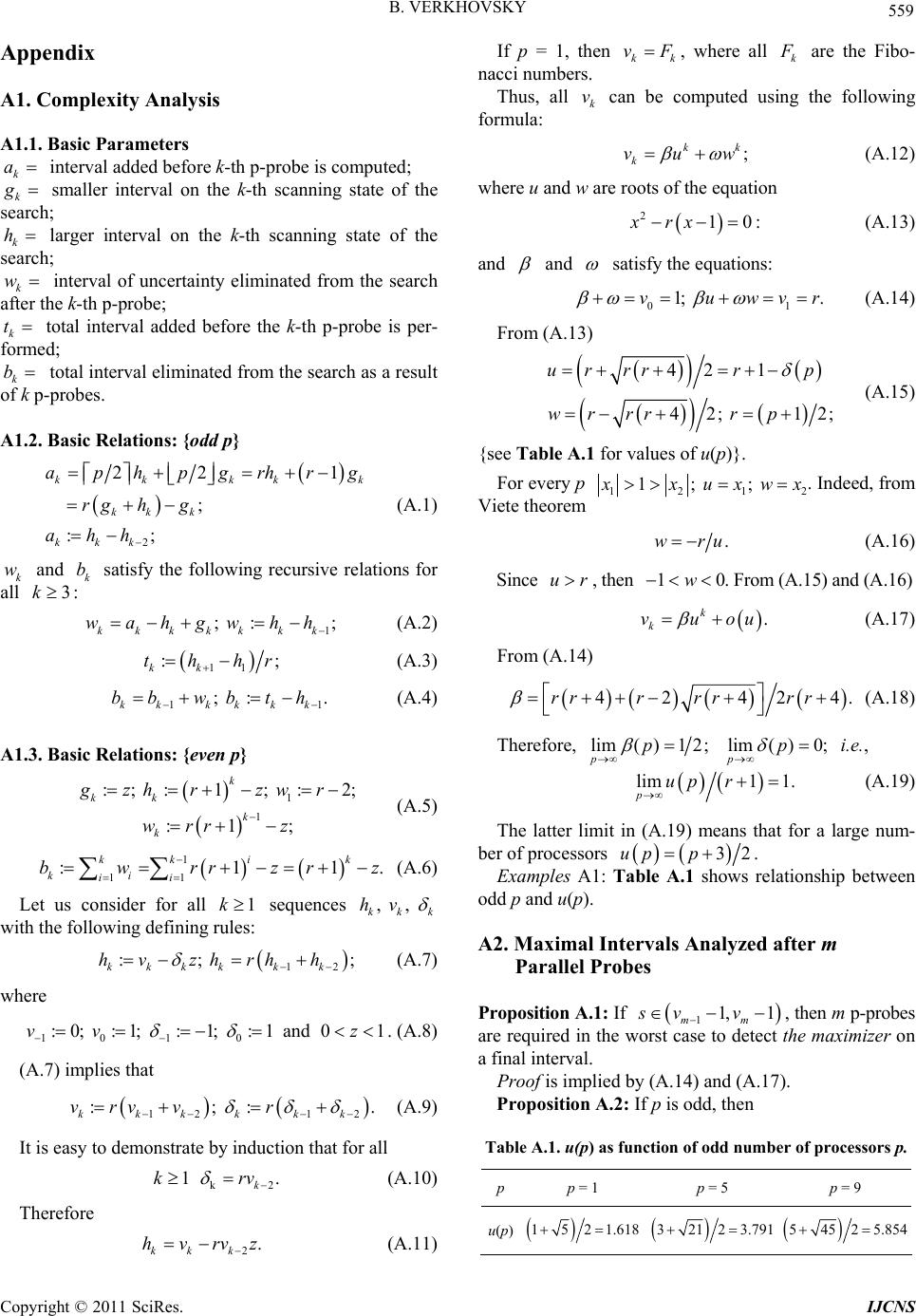 B. VERKHOVSKY 559 Appendix A1. Complexity Analysis A1.1. Basic Parameters k a interval added before k-th p-probe is computed; k smaller interval on the k-th scanning state of the search; k larger interval on the k-th scanning state of the search; h k interval of uncertainty eliminated from the search after the k-th p-probe; w k total interval added before the k-th p-probe is per- formed; t k total interval eliminated from the search as a result of k p-pr o bes . b A1.2. Basic Relations: {odd p} 2 22 1 ; :; kkkk kkk kkk aphpgrhrg rg hg ahh k (A.1) k and k b satisfy the following recursive relations for all w3:k 1 ; :; kkkkkkk wahgwhh (A.2) 11 : kk thhr ; ; 1. k z (A.3) 11 ; :. kk kkkk bb wbth (A.4) A1.3. Basic Relations: {even p} 1 1 :; :1; :2 :1; k kk k k gzh rzwr wrr z (A.5) 1 11 :1 i kk ki ii bwrrzr (A.6) Let us consider for all sequences 1k, , kkk hv with the following defining rules: 12 :; kkkkk k hvzhrh h ; (A.7) where 10 10 :0; :1; :1; :1 and 01vv z . (A.8) (A.7) implies that 12 12 :; : kkkkkk vrv vr . 2 (A.9) It is easy to demonstrate by induction that for all k 1 . k krv (A.10) Therefore 2. kk k hvrvz (A.11) If p = 1, then k vF k , where all k are the Fibo- nacci numbers. Thus, all can be computed using the following formula: k v ; k k vuw k (A.12) where u and w are roots of the equation 210xrx : (A.13) and and satisfy the equations: 0 1; .vuwv 1 r (A.14) From (A.13) 42 1 42; 12 ur rrrp wr rrr p ; (A.15) {see Table A.1 for values of u(p)}. For every p 1212 1; ; xuxwx. Indeed , from Viete theorem .wru (A.16) Since , then ur1 w . From (A.15) and (A.16) . k k vuou (A.17) From (A.14) 42 42rrrrrrr 4. (A.18) Therefore, lim()1 2; pp lim( )0; pp i.e., lim11. pupr (A.19) The latter limit in (A.19) means that for a large num- ber of processors 32up p. Examples A1: Table A.1 shows relationship between odd p and u(p). A2. Maximal Intervals Analyzed after m Parallel Probes Proposition A.1: If 1, 1 mm sv v 1 , then m p-probes are required in the worst case to detect the maximizer on a final interval. Proof is implied by (A.14) and (A.17). Proposition A.2: If p is odd, then Table A.1. u(p) as function of odd number of processors p. p p = 1 p = 5 p = 9 u(p) 1521.618 321 2 3.791 54525.854 Copyright © 2011 SciRes. IJCNS 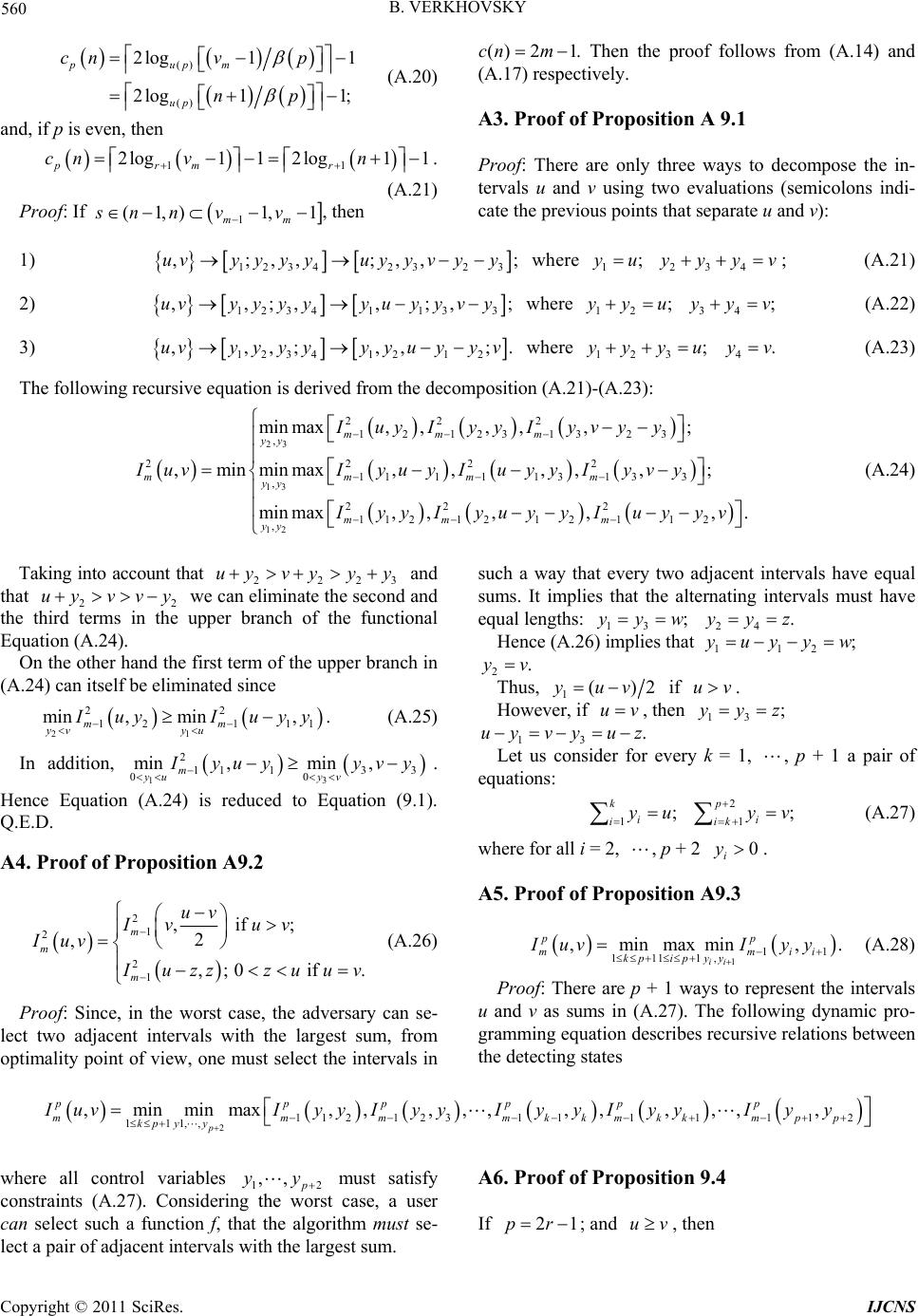 B. VERKHOVSKY Copyright © 2011 SciRes. IJCNS 560 () () 2log 11 2log 11; pupm up cnv p np (A.20) () 21cn m . Then the proof follows from (A.14) and (A.17) respectively. A3. Proof of Proposition A 9.1 and, if p is even, then 11 2log1 12log1 1 prm r cn vn . (A.21) Proof: There are only three ways to decompose the in- tervals u and v using two evaluations (semicolons indi- cate the previous points that separate u and v): Proof: If 1 (1,)1, 1 mm sn nvv , then 1 ) 1234232 3 ,;,,;,,uvyy yyuy yvyy; where 1;yu 234 yyyv ; (A.21) 2) 12341 13 3 ,,;,,;,uvyyyyyu yyv y; where 12 ;yyu (A.22) 34;yyv 3 ) 1234121 2 ,,,; ,,;uvyyyyyyu yyv. where 123 ;yyyu (A.23) 4.yv The following recursive equation is derived from the decomposition (A.21)-(A.23): 23 13 12 222 12 1231323 , 2222 111 113133 , 222 11212 12112 , min max,,,,,; ,minminmax,,,,,; min max,,,,,. mm m yy mmmm yy mm m yy IuyIyyIyvyy IuvI yuyIuyyI yvy yyIyu yyIu yyv (A.24) Taking into account that 2223 uy vyy y and that 22 we can eliminate the second and the third terms in the upper branch of the functional Equation (A.24). uy vvy such a way that every two adjacent intervals have equal sums. It implies that the alternating intervals must have equal lengths: 13;yyw 24 .yyz yu y Hence (A.26) implies that 112 ;yw 2.yv On the other hand the first term of the upper branch in (A.24) can itself be eliminated since 21 22 12111 min,min, mm yv yu uyIuy y . (A.25) In addition, 13 211 13 3 00 min,min , m yu yv yu yyv y . Hence Equation (A.24) is reduced to Equation (9.1). Q.E.D. A4. Proof of Proposition A9.2 21 2 21 , if ; 2 , ,; 0 if . m m m uv Iv uv Iuv uzzzu uv (A.26) Proof: Since, in the worst case, the adversary can se- lect two adjacent intervals with the largest sum, from optimality point of view, one must select the intervals in Thus, 1()yuv2 if . uv However, if uv , then 13;zyy 13 uy vy .uz Let us consider for every k = 1, , p + 1 a pair of equations: 1; k i iyu (A.27) 2 1; p i ik yv where for all i = 2, , p + 2 . 0 i y A5. Proof of Proposition A9.3 111 11, 11 ,minmax min,. ii pp mm kp yy ip IuvI yy ii pp (A.28) Proof: There are p + 1 ways to represent the intervals u and v as sums in (A.27). The following dynamic pro- gramming equation describes recursive relations between the detecting states 21121231 111112 111,, ,minminmax,,,,,,, ,,,, p pppppp mmmmkkmkkm kp yy IuvIyyIyy IyyIyyIyy A6. Proof of Proposition 9.4 where all control variables 12 must satisfy constraints (A.27). Considering the worst case, a user can select such a function f, that the algorithm must se- lect a pair of adjacent intervals with the largest sum. ,, p yy If 21pr ; and , then uv 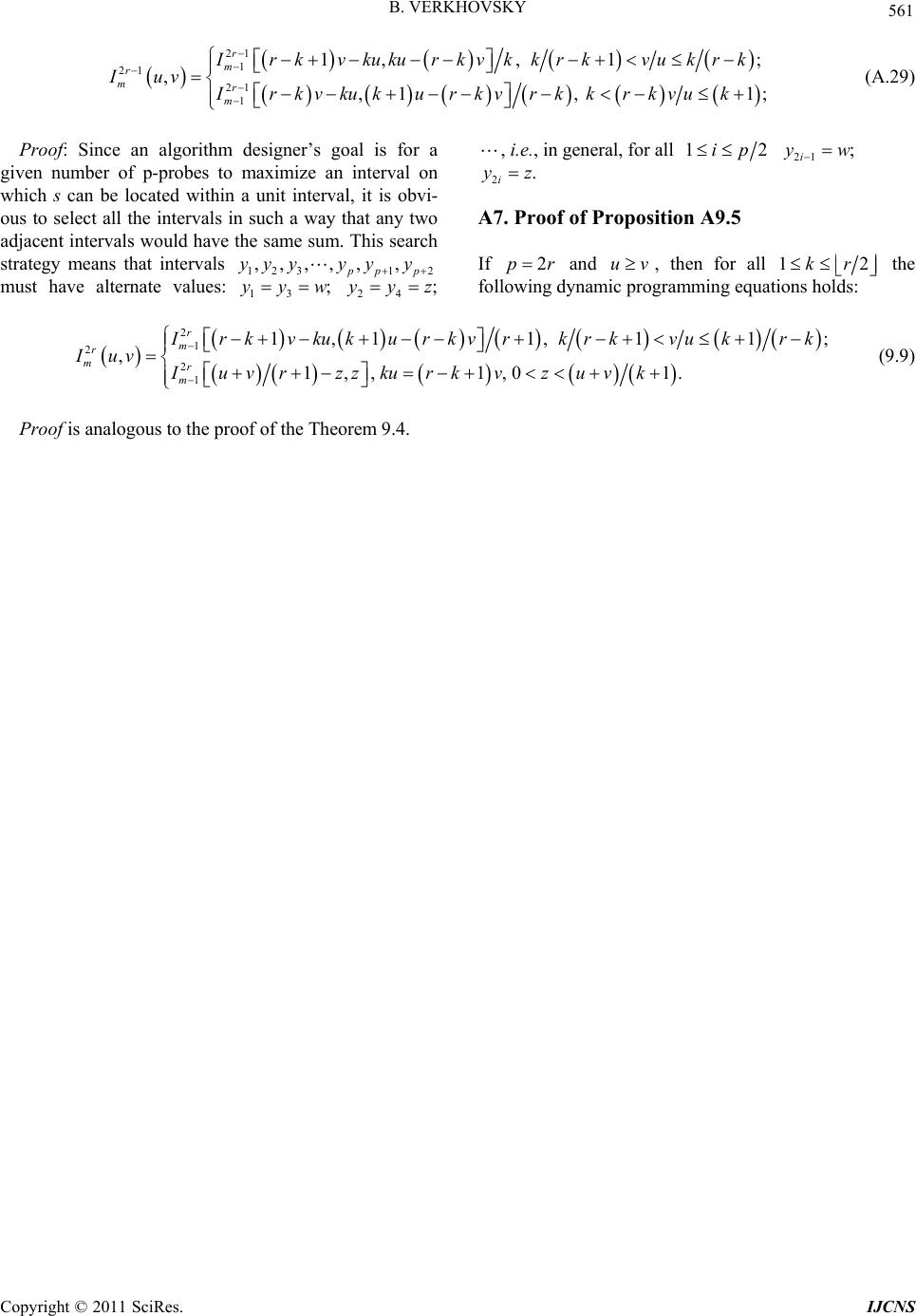 B. VERKHOVSKY Copyright © 2011 SciRes. IJCNS 561 21 1 21 21 1 1,, 1 ,,1, 1 r m r mr m ; ; rkvkuku rkvkkrkvukrk IuvIrkvkukurkvrkkrkvuk (A.29) Proof: Since an algorithm designer’s goal is for a given number of p-probes to maximize an interval on which s can be located within a unit interval, it is obvi- ous to select all the intervals in such a way that any two adjacent intervals would have the same sum. This search strategy means that intervals 1231 2 ,,,,,, pp p yyyy yy 13 ;yyw 24;yy must have alternate values: z , i.e., in general, for all 12ip 21 ; i yw 2i.yz A7. Proof of Proposition A9.5 If 2pr and , then for all uv12kr the following dynamic programming equations holds: 21 2 21 1,11, 11 ,1,, 1, 01. r m r mr m ; rkvkuku rkvrkrkvukrk Iuv Iuvrzzkurkvzuvk (9.9) Proof is analogous to the proof of the Theorem 9.4.
|